|
|
|
Ecology—all about palila
As one of the rarest bird species on the planet, palila are found nowhere else in the world, but a small area on Mauna Kea. They are part of the diverse Hawaiian Honeycreeper group that includes the curved-billed ‘i‘iwi, scarlet ‘apapane, and parrot-like-billed kiwikiu. Distantly related to finches, the palila represent the last of the finch-billed seed eating birds in the main Hawaiian islands.

Plumage
- Yellow head – Males typically have yellow feathers that extend down the back of the skull to the neck, or nape line. On females, this area usually has more grey feathers similar in color to the feathers on their upper back.
- Gray back and whitish belly
- Black bill on adults; yellowish bill on fledglings
- Wing bars (white feathers that look like white stripes) on the wing feathers (median and greater coverts) are used to determine if juveniles are 1-year (1 wing bar) or 2-years old (2 wing bars).
Size
- Length: 7.5 inches tall
- Weight: 1.3 ounces
Food
- Māmane provides over 90% of the palila’s diet. Palila eat the immature seeds, flower parts and nectar, young leaves and buds, and caterpillars in the seeds.
- Fruit from naio trees are the second most common food eaten by palila. It accounts for less than 10% of their diet though.
Reproduction
- Low reproductive rates
- The females select the nest site and the male helps her build it. Nests are not reused in following years.
- Average number of eggs laid per nesting attempt is 2 with a range of 1-4.
- One egg laid per day.
- Incubation lasts 17 days on average and female does all of the incubation.
- Nestlings typically start flying, or fledge, at 25 days old. Parents continue to feed fledglings for up to four months after the fledgling begins to fly.
Movement Patterns
- Fledgling palila typically spend their entire life within 3 miles of their nest tree.
- Adults have small home ranges of ~ 750 acres.
- The most noteworthy movement pattern of Palila is the movement between higher elevation and lower elevation sites of suitable māmane forest as they track the availability of the primary food source, māmane flowers and pods. At one part of the year, trees at higher elevation produce flowers and then pods, providing a year-round food supply. During the other part of the year, trees at lower elevations produce flowers and then pods. Maintaining this large elevational gradient is essential for the survival of palila. They now occupy <5% of their original distribution on Hawai‘i Island and this area is the only remnant of their habitat that still provides the year-round food supply they need.
Survival and Abundance
- 1st year of life = 36% survival
- 2 years and older = 64% survival
- Oldest known palila in the wild = 17 years
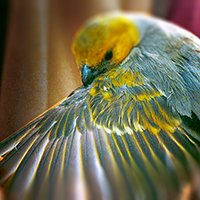
White wing bars are characteristic of the juvenile stage of palila.
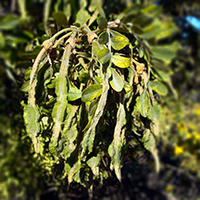
Immature green māmane pods and seeds are the palila’s favorite food
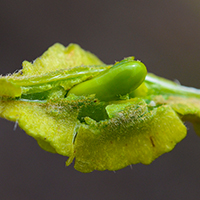
Close up of toxic green māmane seeds that palila depend on.
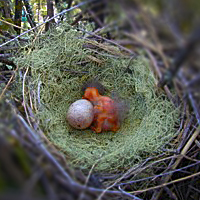
Palila nest with egg and newly hatched chick.
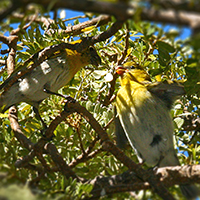
Palila chick being fed by parent.

Chicks are fed larvae found in māmane pods.
2012 population estimate: 1,749 – 2,640 Over the past 10 years (2003-2012) the population decreased by approximately 66%.  |









